The drum of marching feet
Rarely does Beijing back off from a fight. Yet, for now, the people of Hong Kong have won.
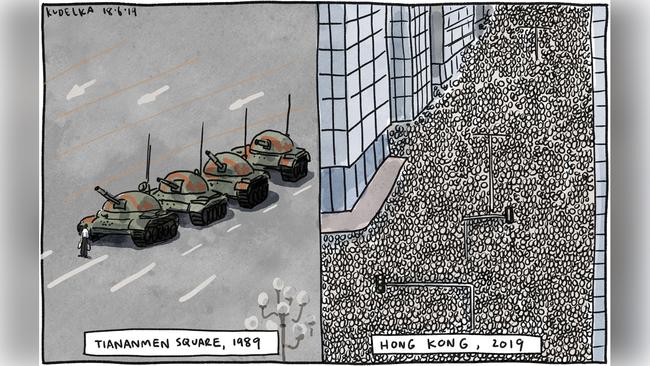
It is stifling hot, a soft breeze from the east the only respite from the summer heat and a sweaty, human tide.
Some marchers carry tiny electrical fans, powered by the batteries of their mobile phones. Others fan themselves with placards calling for the extradition treaty to be scrapped and for the region’s Chief Executive to quit.
If so many people gathered at once in any other city, you would fear chaos, for people to be injured in the crush, for shop windows to be smashed and stores looted, for fights to break out.
MORE: Robert Gottliebsen writes when Beijing finally enforces control, many residents of Hong Kong will want to come to Australia | HK blunder: Authorities in mainland China did not consider the extradition bill a priority | Dissident: Freed dissident tells leader to quit
Yet this is Hong Kong; a Chinese city that still holds fast to the British traditions of democracy, judicial independence and a proper, orderly queue.
As the march inches its way forward, the dark sea of black-clad protesters parts for people distressed by the heat, for protesters in wheelchairs, for ambulances to pass through. There is barely a cop on Hennessy Street and no reports of violence. Beneath our shuffling feet, the streets are remarkably clean. It is one thing to demand the overthrow of the city’s executive; littering is quite another.
Common people revolt
Who are these people who have taken to the streets in defiance of their own government and Beijing? Anyone and everyone.
If the claims of protest organisers are true, up to two million people marched on Sunday. That is nearly one in three Hong Kongers. Not far from the sparkling shopping plazas of Causeway Bay, I fall in step with a man who says he is a local construction worker. He has always lived in Hong Kong, he isn’t a political or union activist and he is not usually given to protest. This time, it is different: “This time they have made the common people come out.”
Beijing is watching
From the streets of Hong Kong, the crisis over the extradition bill — proposed legislation to enable Hong Kong residents to be extradited to mainland China, Taiwan and Macau — is fundamentally a dispute between the people and their own government.
Everyone here understands the bigger political play — that the extradition bill is the latest attempt by Beijing to wind back democratic freedoms promised to Hong Kong for 50 years under the “one country, two systems” terms of the 1997 handover.
Everyone is aware that, on this night, Beijing is watching intently and that there is no bigger story in the world than Hong Kong.
Many of the marchers are veterans of the 2014 Umbrella Movement protests that blocked city streets for 78 days.
Some are old enough to remember mass protests in 2003, when Beijing pressured Hong Kong to create crimes for treason, secession, sedition and subversion against the central government.
They understand that, piece by piece, the things that separate Hong Kong from the rest of China are being tugged and pulled at by the central government.
HK legislators blamed
This protest is not targeted at Beijing, however. It is about the failure of Hong Kong legislators, and particularly the government’s Chief Executive, Carrie Lam Cheng Yuet-ngor, to protect the interests of her constituents against Beijing.
It is about the willingness of Hong Kong legislators to expose the territory’s common law institutions to China’s justice system.
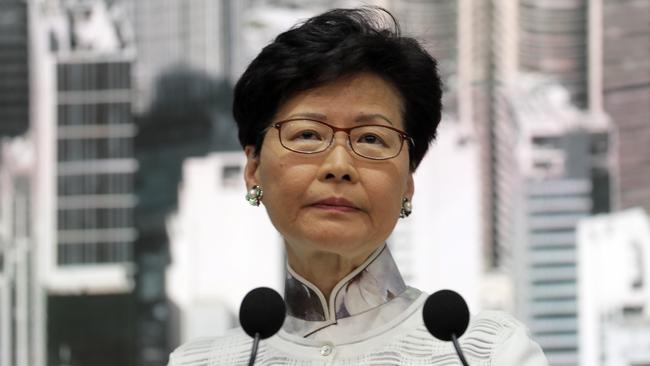
The protesters carry signs lambasting Lam, not Chinese President Xi Jinping.
Ben Ho, 37, is enjoying what should be the best weeks of his life. He has taken time off work to stay at home with his newborn daughter. His princess, he calls her.
Now he has taken time away from his daughter to march. He bristles at Lam’s suggestion that her only failing was to inadequately explain the extradition bill.
“We are not the ones who don’t understand,” he tells The Australian. “She is the one, Carrie Lam, who doesn’t understand.
“One of the foundations for Hong Kong to be successful, from the British colony until now, is freedom — freedom of speech, freedom of religion. Bit by bit, she is degrading pretty much everything that makes Hong Kong, Hong Kong. They just want to please Beijing and keep doing stupid stuff in the wrong way and not in our best interests.”
As we pass through the Wan Chai district, where home improvement and bathroom supply shops give way to English-themed bars filled with Filipino escorts and expat sleaze, I strike up a conversation with IT worker Branco Lam, 24.
Branco graduated last year from the University of Hong Kong. Like may Hong Kongers, he is a Canadian citizen — the benefit of a generous family reunion program that allowed Hong Kong residents with distant relatives living in Canada to take up citizenship. This gives him options.
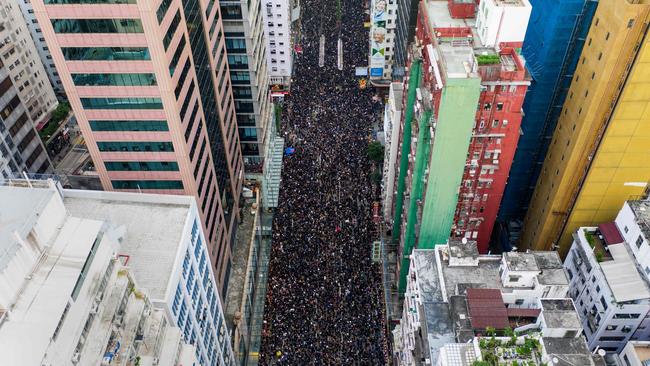
He is pessimistic about the future here.
“There are many things that show us that we are going to lose freedoms,” he says.
Despite this, he has no plans to leave. He says he loves this city and what he calls its “team spirit”. He is rostered to work tomorrow but, along with many in this city, will call in sick.
Annette Lo has been marching for six hours and is carrying her nine-year-old niece through the streets. She is a history and sports teacher who walks on strong, tennis-player legs.
She is marching for her students, she says, so that when they grow up they still will have a voice in Hong Kong’s affairs.
In her history classes she teaches the best and worst of China; the great dynasties and rise of Mao Zedong; the atrocities of Tiananmen Square.
“We always teach them to have critical thinking,” she says.
Teachers in Hong Kong are concerned that if the government yields to Beijing on the extradition legislation, school curriculums could be next.
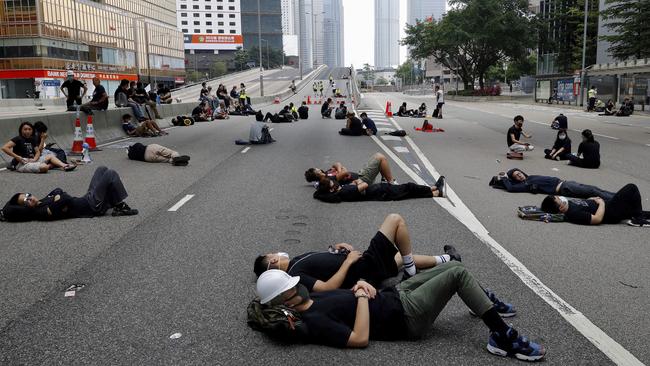
Raincoat man
As Hennessy Road becomes Queensway, we pass the place where a protester wearing a plastic yellow raincoat fell to his death from a 10-storey building site.
He is the first and, so far, only fatality of the Hong Kong crisis, despite the violent clashes between protesters and police last Wednesday that left more than 80 people injured.
He died within hours of Lam announcing she would suspend the extradition bill until after the Legislative Council’s summer recess. The marchers call him raincoat man. Many carry white flowers in tribute.
Linguistics student Cherry Lam, 22, says the story of raincoat man has caused many more protesters to take to the streets. It is unclear whether he jumped or fell. Either way, he has become a martyr to the movement. A yellow raincoat, like an umbrella, is now a democratic meme.
Lam says it is ridiculous that in modern Hong Kong people are dying for their freedom. “If we don’t do something now the future will be very upsetting,” she says.
Lam is in her final year of study and lives in a residential hall at the University of Hong Kong. Last Thursday, police arrested two students who live in the building next door and were identified as being involved in Wednesday’s violent protests. As we walk, Lam reads the Cantonese protest signs hanging from street overpasses and interprets the loudhailer chants of march organisers.
“Carrie Lam is a murderer”, reads one painted sign. They chant in unison “release, release” — a call to release leaders of the Umbrella Movement still in jail.
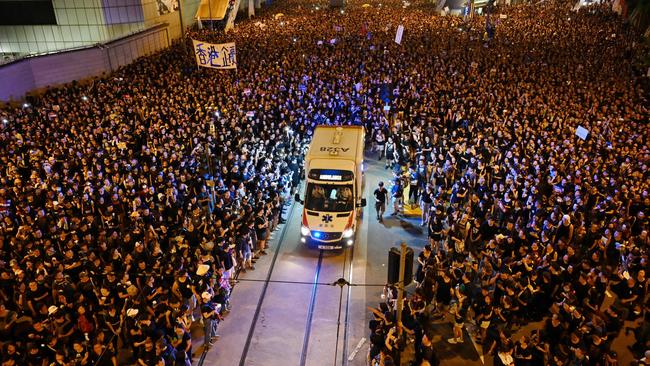
Lam relents
Well into the night, Carrie Lam releases a statement. Its tone is obsequious. It carries no trace of her determination expressed only a day earlier to build public consensus behind the extradition bill.
“The Chief Executive clearly heard the views expressed in a peaceful and rational manner,” the statement reads.
“She acknowledged that this embodies the spirit of Hong Kong as a civilised, free, open and pluralistic society. The government also respects and treasures these core values of Hong Kong.”
The Chief Executive says there is no timetable for rebooting the legislation: “The Chief Executive admitted deficiencies in the government’s work led to substantial controversies and disputes in society, causing disappointment and grief among the people. The Chief Executive apologised to the people of Hong Kong for this and pledged to adopt a most sincere and humble attitude to accept criticisms and make improvements serving the public.”
There is more to come. Yesterday Joshua Wong, the face of the Umbrella Movement, walked free from jail. He is released a month before his sentence is fully served. In his first public comments as a free man, he calls for the Chief Executive to stand down.
Rarely has a government bent so dramatically to the will of its people. Rarely does Beijing back off from a fight against its own. Yet, for now, as life in Hong Kong returns to its normal rhythms, the people have won.

It isn’t so much a march as a shuffle. Along Hong Kong’s Hennessy Road, a wide boulevard connecting the city’s retail precinct to its financial and administrative heart, we walk with small, patient steps beneath a dark sky, a million people in calm, purposeful procession.